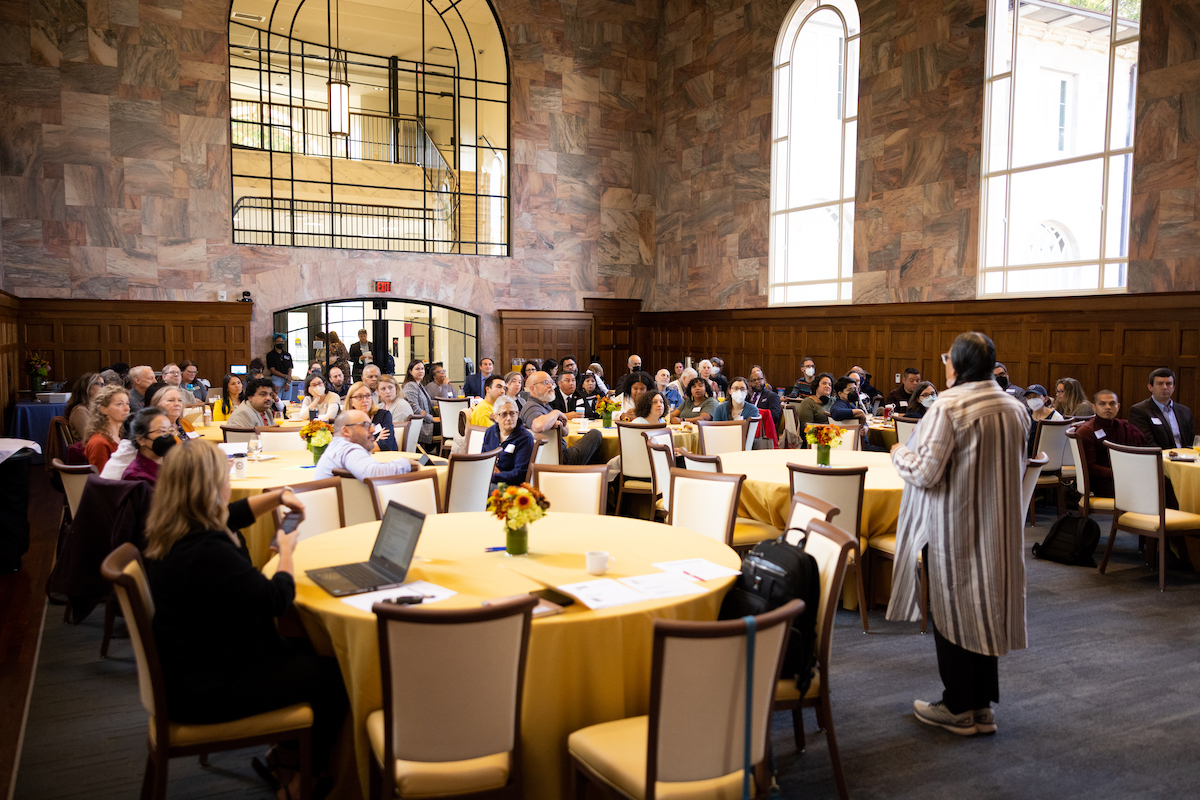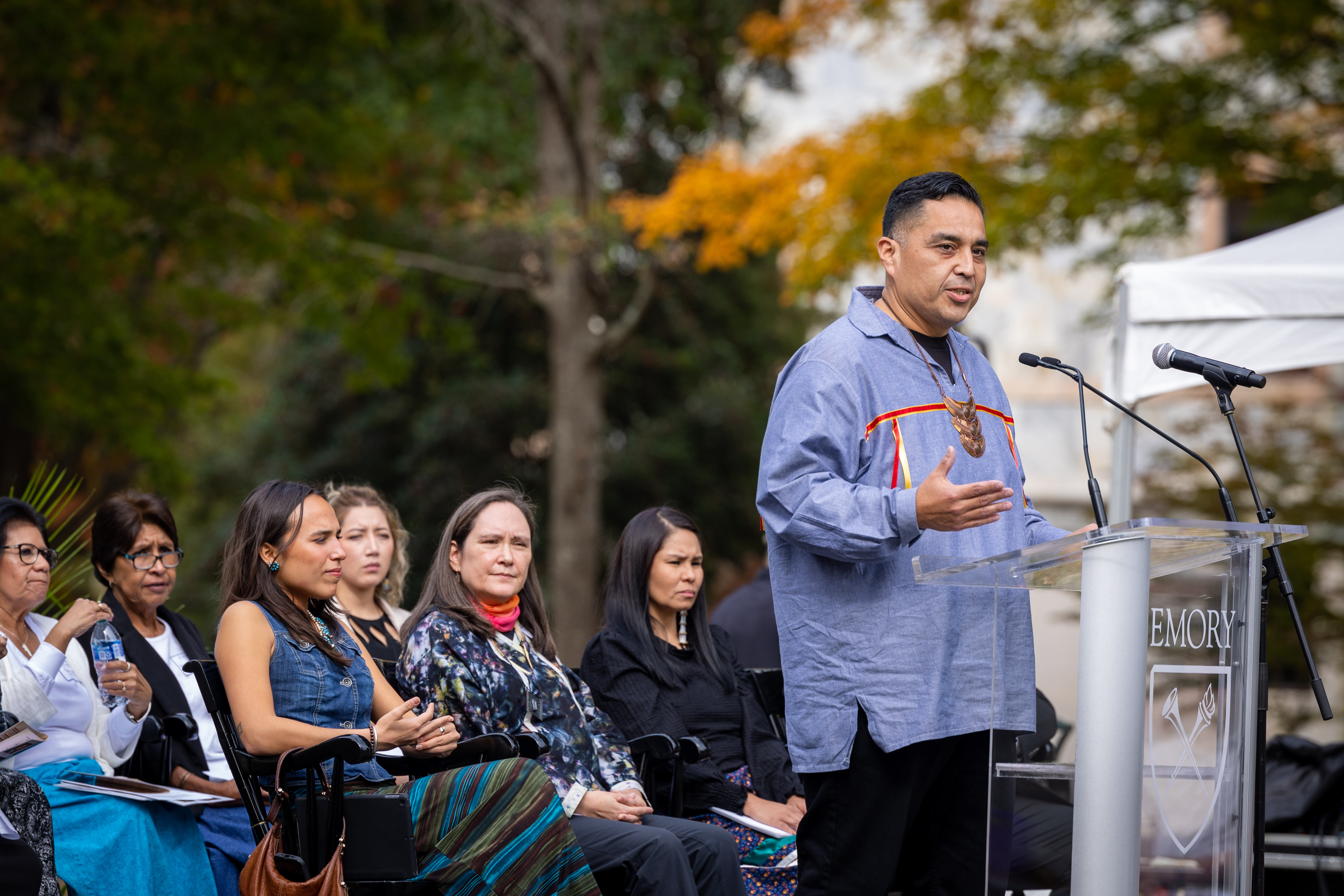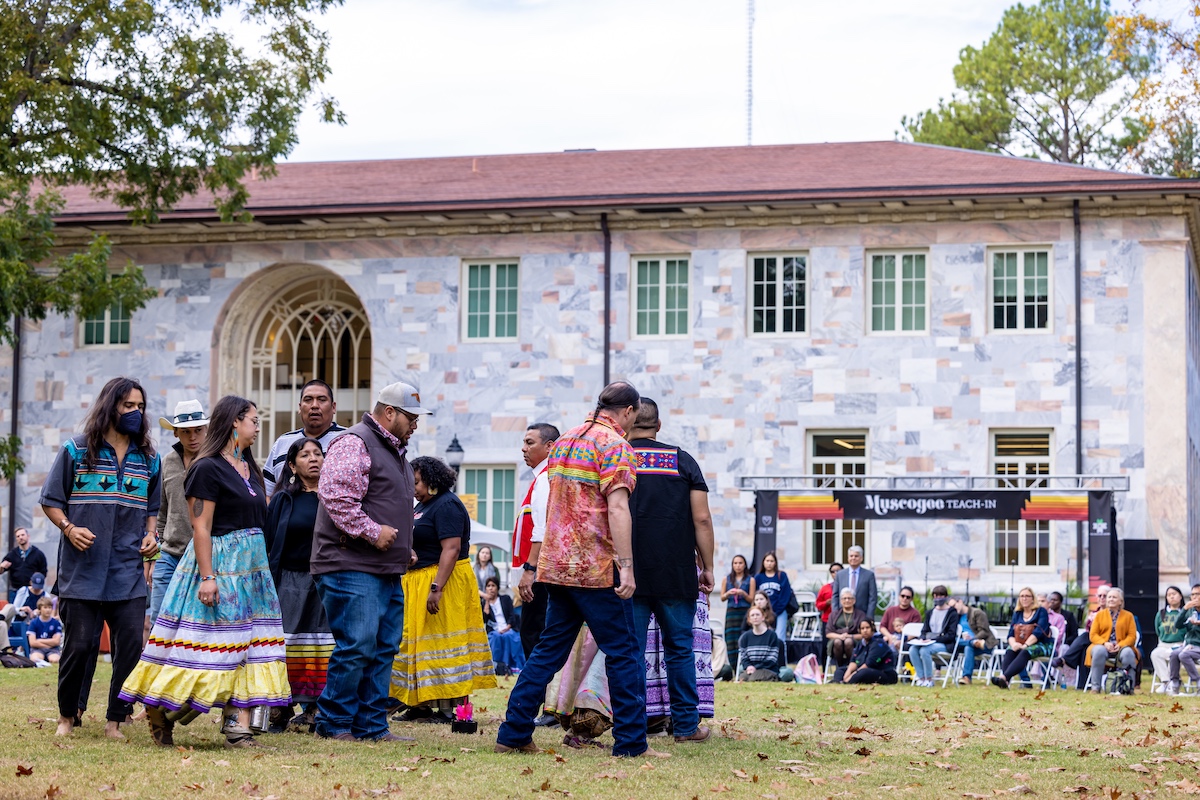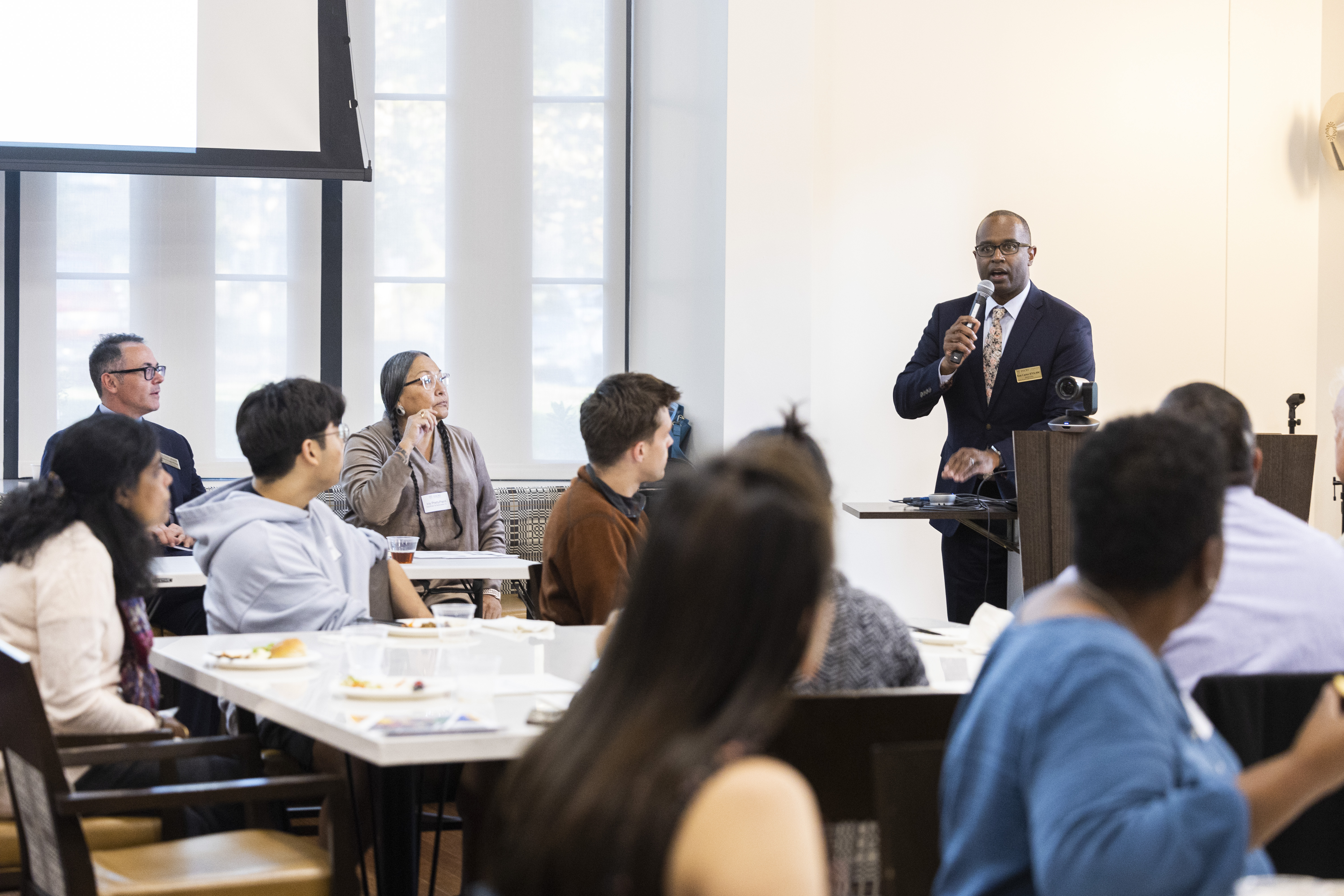The closing days of October never fail to bring a bounty: cooler temperatures; the gorgeous golds, yellows and reds of the falling leaves; and every good excuse to drink hot apple cider.
On Oct. 27 and 28, Emory experienced that — and much more — during the Muscogee Teach-in and listening sessions sponsored by the Indigenous Language Path Working Group. Beth Michel (Tohono O’odham), senior associate dean of admission and the admission office’s lead for Native American affairs, did much of the work of organizing this singular event.
Welcoming a crowd of about 200 to the Quad for the teach-in on the afternoon of Oct. 28, Carol Henderson said, “Welcome to this year’s teach-in. I say ‘this year’s teach-in’ because I think we can do this again,” to which the audience reacted with excited applause.
Henderson — vice provost for diversity and inclusion, chief diversity officer and adviser to the president — described the day’s events as “the next steps in a journey to recognize Emory’s complex legacy, to engage a painful history with the Muscogee Nation and Cherokee people that is ever-present but has not yet been acknowledged in ways that honor the land or people who were its original stewards. I hope that changes today.”
The day brought strong hope for the future relationship between Emory and the Muscogee Nation in many ways, including the fact that Second Chief Del Beaver brought his daughter Olivia, currently in the eighth grade, to witness this inflection point. He imagined what she might say upon a return to campus in the future, once the language path takes shape and the bonds have continued to deepen. Noted Beaver, “This has truly been a relationship where we can trust each other. We appreciate the administration of Emory University in establishing that trust. We don’t yet know what this language path can be, but we are on the ground floor of something special.”
Echoing Beaver, Monte Randall (Muscogee), president of the College of the Muscogee Nation, observed that Emory’s interest in walking a future path with the Muscogee Nation touches all levels: “In our visits and conversations, there is genuine investment on the part of students, faculty and staff, all the way up to President Fenves, in the work taking place,” he said.
Before the rich slate of activities got underway — hymn singing, a cultural lab, Muscogee stories and stomp dancing — two members of the Indigenous community at Emory greeted the Muscogee Nation representatives.
In her native language, Sierra Talavera-Brown 23C (Diné) said: “To my Muscogee relatives, it is beautiful that you are home and that you came home safely.” Continuing in English, Talavera-Brown — who serves on the working group — asked audience members to “listen deeply and hear the wisdom embedded in the Muscogee stories and knowledge. May we use this experience to illuminate a path of transformation, create new stories together and celebrate Muscogee people and culture.”
Faculty member Heidi Senungetuk (Kingikmiut Inupiaq) pointed out that “the work that Emory has taken on to develop lasting relationships with the Muscogee Nation is so important for Indigenous students, faculty and staff. We bring diverse ways of knowing to this campus and, like all of you, find connections with our colleagues, with the land and with our hearts.” Senungetuk, an assistant teaching professor, is a violinist and ethnomusicologist in Emory’s Department of Music who researches Indigenous music of Arctic regions.
A rich lesson plan
With that, the artists took center stage, led by Mvhayv (or “teacher”) Gracine Hicks, Mvhayv Rebecca Barnett and Judy Montiel, who sang “Hvthvyatken Vlicecet” (“Encouragement Hymn”). For those who missed the live performance, the Muskogee (Seminole/Creek) Documentation Project offers another way to hear the hymn.
Britteny Cuevas — owner of Four LOCV, which specializes in Native American, Southeastern Indigenous arts — taught audience members how to create Corn Husk People and Woven Game Balls, used in stickball. Relating her own journey to learn complex skills like ribbon tying and basket weaving from her elders, Cuevas also relayed some of the Muscogee oral history, including ancient stories of Corn Woman and migration associated with Woven Game Ball.
The Muscogee Nation’s secretary of education and training, Kaila Harjo, introduced the segment on Muscogee stories. Harjo and others are proactively ensuring that the Muscogee language does not suffer extinction. In a nation of some 93,000+ citizens, there are only 250-400 fluent speakers and an even lower number — around 50 — who can read and write Muscogee. Describing the language as the “heart beat of our Nation,” Harjo introduced Mvhayv Gracine Hicks and Mvhayv Rebecca Barnett, who related the creation stories “Why the Opossum Has a Bare Tail” and “Story of Night and Day.” She and her staff are taking promising steps to preserve the language.
Rounding out the afternoon, Rev. Chebon Kernell led members of the Helvpe ceremonial ground and the Emory community in stomp dancing. Kernell is executive director, Native American Comprehensive Plan, and executive secretary of Native American and Indigenous Ministries of the General Board of Global Ministries of the United Methodist Church; he also serves on the working group. The stomp dance is a set of traditional social and religious dances brought across the Trail of Tears from the Muscogee ancestral homelands in Georgia and Alabama. During the stomp dances, President Gregory L. Fenves and Carmel Fenves were observers, and Carmel Fenves joined one of the dances along with many other members of the Emory community.
In Convocation Hall on the morning of Oct. 28, a representative of Kauffman & Associates, a Native-led and women-owned consulting firm, leads the faculty/staff listening session for the Indigenous Language Path.
Listening sessions enriched by Muscogee participation
In listening sessions on the Oxford and Atlanta campuses, Kauffman & Associates (KAI) gave Emory faculty, staff and students — alongside members of the Muscogee Nation — a chance to add recommendations to an already robust list of creative ideas expressed at previous sessions about what the language path may be. KAI is a Native-led and women-owned consulting firm assisting the efforts of the working group.
Participants addressed the charge President Fenves made to the working group: to honor the Indigenous peoples who lived on land where Emory is now located, including the development of “physical reminders and remembrance rituals on campus, such as a Muscogee (Creek) Language Path that highlights Muscogee language, culture, knowledge and relationships.”
Convening the sessions, Gregory W. McGonigle, co-chair of the working group and dean of religious life and university chaplain, said: “What we are doing together is not only a physical path but a path of relationship with the Muscogee people, a way to walk together.”
Asked to provide participants a sense of the Muscogee worldview, Kernell stressed the sacred nature of the Earth and the importance of being humble. “We are,” he noted, “doing what we can to perpetuate our way of life,” after sharing that, from the original population of Indigenous peoples, only .004 percent survive. “We still are recovering from the trauma of removal and displacement. Internally, we have to figure out what it means to return to our homeland,” said Kernell.
Kim Collins, head of Emory Libraries’ Research, Engagement and Scholarly Communications Division, found her session “a meaningful opportunity to learn more about an important part of our history that needs to be shared much more broadly. Rev. Kernell provided a brief but fascinating glimpse of the Muscogee worldview. As we commit to understanding the complexity of that worldview, we can unlock a shared foundation and create a physical pathway on both campuses that will help tell this story more broadly.”
The working group will submit its report to the president this fall, outlining next steps and a conception of what the Indigenous Language Path could be.
The word heard most often on campus those two days? “Mvto (muh-doe),” the Muscogee word for thank you. It was simple but fitting, used not only by members of the Nation but also by the latest of the Nation’s language students — the Emory community.





